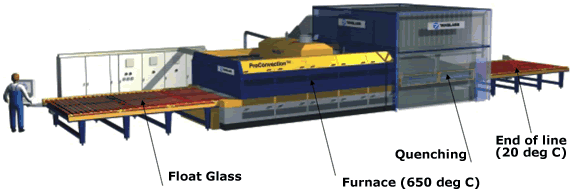Glass use in buildings has many uses. The obvious being allowing light into the building and enabling people to see in and out of a building while keeping elements of weather at bay.
Bullet proof glass.
Security.
Bullet proof glass enables buildings to be secure.
Bullet proof glass has 2 glass layers combined. One layer is soft while the other is hard. The softer glass prevents the glass from shattering.
One layer is made from polycarbonate material while the other is made from ordinary glass. These 2 layers are joint together through a process called lamination.
Bullet proof glass has a thickness varying from 19mm to 76mm.
The thicker the glass, the more resistant it is to more powerful guns.
There is also one way bullet proof glass that allows bullets to pass through the glass from one direction and stops bullets from penetrating through the glass from the other direction. These are used whereby the occupants of the room protected by the bullet proof glass might want to return back the fire.
Such glass is mainly used in cars and banking halls .
Toughened glass.


This is made when ordinary glass is put through a 650 degrees hot furnace for several minutes. It’s then rapidly cooled to a temperature of 20 degrees.
The heat causes the glass outer surfaces to expansion and the inner parts into tension.
This causes the glass to turn into small crumb like pieces when broken due to the residual tensile and compressive forces stored within the glass.
These stored forces also make the glass around 5 times as strong as ordinary glass.
Uses.
Its most commonly used in side and rear windows of cars.
Disadvantage.
Toughened glass can not be reworked once its taken through the process of toughening. No chiseling, grooving or cutting can occur since any incision tends to allow the massive energy stored inside the glass through the heating and cooling process to be released through breaking into thumbnail pieces.
Toughened glass has the same effect as dropping molten glass in a bucket of cold water. The molten glass forms into a tear drop shape called the Prince Rupert’s drop. The larger head end is usually very strong and can withstand strong blows while the tail end is very weak and any slight force causes the whole drop to shatter immediately due to the high energy stored within it.

Toughened glass currently costs around kes 8,000 per m2 in Kenya.
Laminated Glass.
This was invented in 1903 by French chemist Edouard Benedictus through an accident. A glass flask coated with plastic cellulose nitrate fell but did not break.
Benedictus then fabricated a glass plastic composite in order to reduce car accidents caused by broken glass.
To date, car windscreens use laminated glass for the safety reason.
Also, most shop fronts and areas where broken glass can come in contact with people usually have laminated glass due to its high safety level.When broken, it sticks together.
A typical laminated glass is usually 2.5mm glass, 0.38mm polycarbonate laminate in between, then a 2.5mm thick glass at the end, making a sandwich.
The polycarbonate sandwich in the middle can be replaced with decorative patterned cloth material or any other material to create interesting effects.
The sandwich material makes it hard to cut, hence the laminated glass sizes need to be exact when being used in architectural projects.
Laminated glass blocks UV rays and also is very effective in sound proofing, due to the sandwich material in between.
Window film on Glass.
This is a thin layer of film applied on one side of the glass surface.
Uses.
1. Helps prevent UV rays from the sun from entering the building.
2. Ensures privacy while bringing in light, through use of tinted film or obscured film.
3. Enhances aesthetics through use of patterned film.
4. Prevents glass from injuring people in case of breakage.
5. Prevents easy break ins from burglars.
6. Helps to control glare.
Francis Gichuhi Kamau, Architect.
info@a4architect.com


Leave a Reply